Potawatomi vs German Family Households with Children
COMPARE
Potawatomi
German
Family Households with Children
Family Households with Children Comparison
Potawatomi
Germans
26.9%
FAMILY HOUSEHOLDS WITH CHILDREN
2.2/ 100
METRIC RATING
247th/ 347
METRIC RANK
27.1%
FAMILY HOUSEHOLDS WITH CHILDREN
8.7/ 100
METRIC RATING
224th/ 347
METRIC RANK
Potawatomi vs German Family Households with Children Correlation Chart
The statistical analysis conducted on geographies consisting of 117,721,080 people shows a moderate positive correlation between the proportion of Potawatomi and percentage of family households with children in the United States with a correlation coefficient (R) of 0.401 and weighted average of 26.9%. Similarly, the statistical analysis conducted on geographies consisting of 579,972,630 people shows a mild positive correlation between the proportion of Germans and percentage of family households with children in the United States with a correlation coefficient (R) of 0.325 and weighted average of 27.1%, a difference of 0.81%.

Family Households with Children Correlation Summary
| Measurement | Potawatomi | German |
| Minimum | 10.6% | 16.1% |
| Maximum | 53.7% | 60.0% |
| Range | 43.0% | 43.9% |
| Mean | 25.5% | 28.8% |
| Median | 25.3% | 27.3% |
| Interquartile 25% (IQ1) | 19.2% | 26.0% |
| Interquartile 75% (IQ3) | 28.0% | 29.0% |
| Interquartile Range (IQR) | 8.8% | 3.0% |
| Standard Deviation (Sample) | 8.4% | 7.2% |
| Standard Deviation (Population) | 8.3% | 7.2% |
Similar Demographics by Family Households with Children
Demographics Similar to Potawatomi by Family Households with Children
In terms of family households with children, the demographic groups most similar to Potawatomi are Immigrants from Kazakhstan (26.9%, a difference of 0.010%), Immigrants from Eastern Europe (26.9%, a difference of 0.030%), Belgian (26.9%, a difference of 0.030%), Jamaican (26.9%, a difference of 0.060%), and Immigrants from Bosnia and Herzegovina (26.8%, a difference of 0.090%).
| Demographics | Rating | Rank | Family Households with Children |
| Immigrants | Bulgaria | 3.3 /100 | #240 | Tragic 26.9% |
| Navajo | 3.2 /100 | #241 | Tragic 26.9% |
| Immigrants | England | 3.2 /100 | #242 | Tragic 26.9% |
| Immigrants | Saudi Arabia | 2.9 /100 | #243 | Tragic 26.9% |
| Ukrainians | 2.9 /100 | #244 | Tragic 26.9% |
| Australians | 2.8 /100 | #245 | Tragic 26.9% |
| Jamaicans | 2.5 /100 | #246 | Tragic 26.9% |
| Potawatomi | 2.2 /100 | #247 | Tragic 26.9% |
| Immigrants | Kazakhstan | 2.2 /100 | #248 | Tragic 26.9% |
| Immigrants | Eastern Europe | 2.1 /100 | #249 | Tragic 26.9% |
| Belgians | 2.1 /100 | #250 | Tragic 26.9% |
| Immigrants | Bosnia and Herzegovina | 1.9 /100 | #251 | Tragic 26.8% |
| Irish | 1.8 /100 | #252 | Tragic 26.8% |
| Italians | 1.5 /100 | #253 | Tragic 26.8% |
| Immigrants | Scotland | 1.5 /100 | #254 | Tragic 26.8% |
Demographics Similar to Germans by Family Households with Children
In terms of family households with children, the demographic groups most similar to Germans are Pima (27.1%, a difference of 0.030%), Paraguayan (27.1%, a difference of 0.050%), New Zealander (27.1%, a difference of 0.060%), Austrian (27.1%, a difference of 0.080%), and Canadian (27.1%, a difference of 0.090%).
| Demographics | Rating | Rank | Family Households with Children |
| U.S. Virgin Islanders | 12.1 /100 | #217 | Poor 27.1% |
| Greeks | 11.4 /100 | #218 | Poor 27.1% |
| Immigrants | Japan | 10.7 /100 | #219 | Poor 27.1% |
| Austrians | 9.9 /100 | #220 | Tragic 27.1% |
| New Zealanders | 9.6 /100 | #221 | Tragic 27.1% |
| Paraguayans | 9.4 /100 | #222 | Tragic 27.1% |
| Pima | 9.2 /100 | #223 | Tragic 27.1% |
| Germans | 8.7 /100 | #224 | Tragic 27.1% |
| Canadians | 7.5 /100 | #225 | Tragic 27.1% |
| Czechoslovakians | 6.6 /100 | #226 | Tragic 27.0% |
| Tsimshian | 6.6 /100 | #227 | Tragic 27.0% |
| Scottish | 6.5 /100 | #228 | Tragic 27.0% |
| Immigrants | Caribbean | 6.3 /100 | #229 | Tragic 27.0% |
| Bulgarians | 5.8 /100 | #230 | Tragic 27.0% |
| Luxembourgers | 5.5 /100 | #231 | Tragic 27.0% |